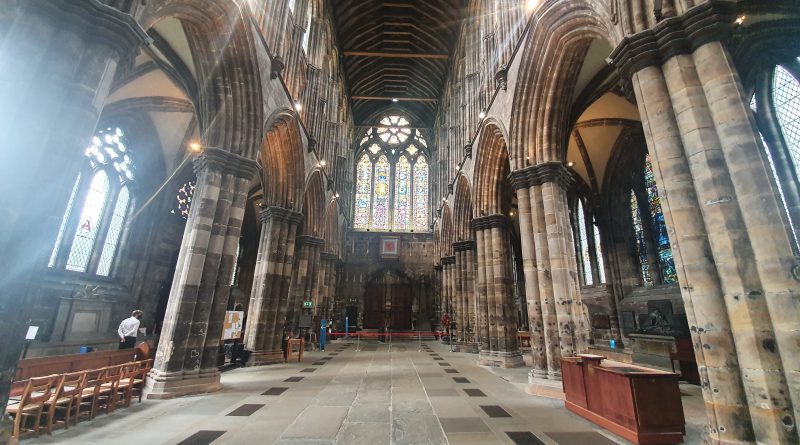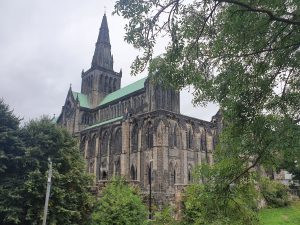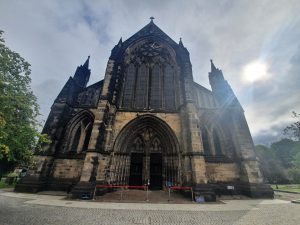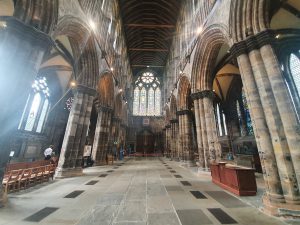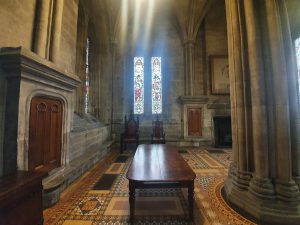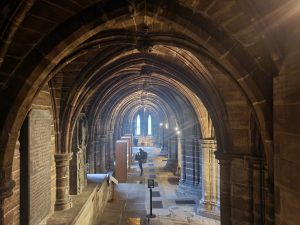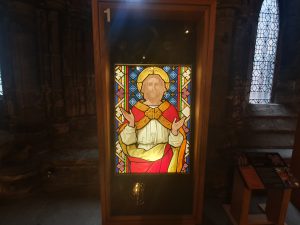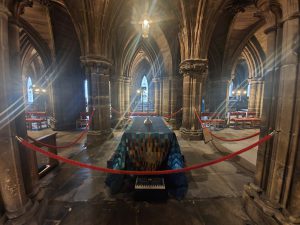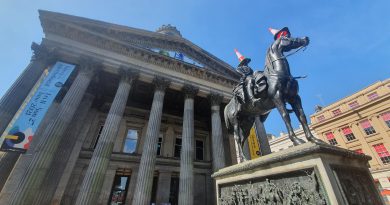Glasgow – Glasgow Cathedral
I’ve done that annoying thing I do (one of many to be fair) of taking way too many photos of an historic location and then struggling to fit it all into a blog post without it becoming overlong. So, I’ll keep this short and if I ever get time start to add some of the other historic elements into other posts. It’s an important building as it’s the only medieval cathedral in mainland Scotland that has remained relatively intact since it was constructed. Well, other than when the Victorians knocked down the two towers at the western end in the mistaken belief that they were more recent constructs. They weren’t.
The history of this building dates back to 614 when St. Mungo (also known as Kentigern) buried a holy man named Fergus at this site, building a small church. When St. Mungo died, he was buried here and that was the end of the matter for some centuries. Then, a decision was made in 1136 to build a cathedral on the site of the church, which was later replaced by a more substantial thirteenth century building.
Back to my visit, visitors had to pre-book a ticket on-line, although there was no charge for doing so. I was saddened a little to see an elderly gentleman at the entrance to the door who was trying to explain that he didn’t know he needed a ticket and he was really keen to visit as he had been to some other historic abbeys and churches in Scotland and had been looking forwards to this one. They didn’t let him in.
As for the Covid handling, the cathedral is managed by Historic Environment Scotland and I’m entirely puzzled who has come with the idea that they’ve had to introduce a one-way system which huddles everyone close together. They have an enormous cathedral and they’ve created little aisles to corral visitors into, making social distancing as hard as they possibly could. Anyway, I had an exciting building to look around so just waited patiently in the queue that they’ve created.
The nave, which was an open area of the cathedral where visitors could walk where they wanted. Out of the photo and behind me there were about fifteen people crammed into one small section of the building working through the cathedral’s one way system.
Back to my little history. Following the Reformation in Scotland, the cathedral started to fall into disrepair (not helped when someone pinched all of the lead) and there was talk of it being entirely demolished as an unnecessary structure. To be fair, the talk was likely from someone who planned to sell the stone off or similar, a fate that led to the destruction of the neighbouring castle. Then it was decided that it would be a handy place for Protestant worship and repairs were put in hand, but not much beyond that. The Victorians knocked the building about a bit, but there hasn’t been a reason for any major changes since the Reformation, hence the survival of the main fabric of the medieval cathedral.
The chapter house and whilst visiting I had a little dilemma here. I waited patiently at the top of the stairs as the signage said one household group only could look around it at the same time. Then the helpful volunteer told me to go down as one more person would be fine. I think I then annoyed the couple who had also patiently waited to go down that I looked impatient and was trying to hurry them.
The cathedral’s crypt.
In the 1860s, it was decided to make a major investment and the stained glass in the nave and choir was removed and replaced with glass from Munich. This seemed a good idea, but the Munich glass started to fade and it was agreed that this wasn’t ideal, so it was taken out in the 1930s. Some of it has been placed around the crypt where it’s dark and won’t fade.
The centrepiece of the cathedral is the burial place of St. Mungo. In medieval times, this was a place of pilgrimage and I was amused to note that the authorities at the time created a complex one-way system to add anticipation to a visit to the tomb. These pilgrims created a substantial amount of wealth for the cathedral, a revenue which was lost following the Reformation in Scotland.
Anyway, this is a beautiful building with a complex history, but with much original structure from the thirteenth century. I’m not entirely sure that the cathedral’s social distancing is working as well as it could, but the staff were friendly, helpful and engaging. There were also numerous interpretations boards around the cathedral which gave useful information about the history of the structure. It was certainly worth getting a ticket to visit the building, although I’d add that I got muddled up near the end of the visit and went the wrong way to try and exit. The staff member told me not to worry as lots of visitors got confused there, although they probably didn’t and she was just being polite.

